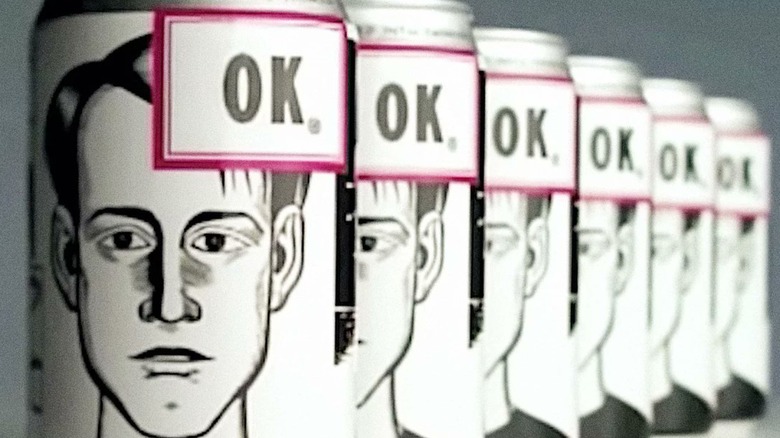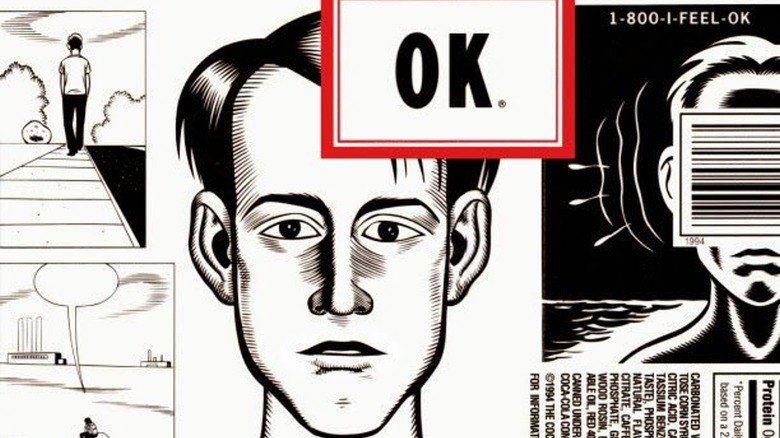Why Coca-Cola's Discontinued OK Soda Couldn't Get Off The Ground
It's the early 1990s. Grunge culture, fueled by bands like Nirvana, Pearl Jam, and Stone Temple Pilots, made huge strides. Ripped and acid-washed denim was commonplace, and a general feeling of what someone could describe as "apathetic disillusionment" pervaded. Indeed, Generation X has long been viewed as the generation that shrugs its shoulders, says "Whatever, man," and embraces a philosophy that nothing, be it politics or economics, really matters. But to Coca-Cola, Generation X was just another market ripe for the picking.
That's why, in 1993, Coca-Cola debuted OK Soda, a new type of soda specifically designed to be marketed to this younger, grungier generation. Yet, for some reason, this strange and surreal take on soda didn't make it far, barely lasting a few months on the test market before being discontinued. How could OK Soda have been discontinued so quickly? What made it so unique? The answers to these questions involve alternative cartoonists, an attempt to mimic the apathy and cynicism of Generation X, and the vague yet comforting feeling that everything will be "OK."
OK Soda's marketing campaign was purposely offbeat
In 2023, most advertisements are flashy and loud, and do everything they can to be as "relatable" to the consumer as possible. In 1993, OK Soda tried to be relatable to the younger teen market, except it traded in the flashy colors and quirky sayings for the offbeat, the odd, and general apathy. It was marketed as a soda that wasn't trying to be your friend or convince you that be cool drinking it. It was a soda and it was OK.
To this end, Coca-Cola made everything about its soda as unconventional as possible. The company commissioned celebrated alternative cartoonists Daniel Clowes and Charles Burns to decorate the cans in surreal, monotone comic characters and bleak, harsh backdrops. Marketing slogans were crafted to be as neutral and as indifferent as possible, featuring such catchy slogans as "What's the point of OK? Well, what's the point of anything?" and "There is no real secret to feeling OK." The commercials traded the usual pep and optimism for a more "postmodernist" aesthetic. According to TIME, even Coca-Cola's official description of the drink didn't hype it up at all, likening it to "carbonated tree sap."
While certainly a "creative" approach to advertising, self-imposed negativity and attempts to copy the cultural feeling of a generation weren't enough to keep OK Soda afloat.
OK Soda just didn't resonate with its targeted market
OK Soda never really achieved full-fledged nationwide distribution. Instead, it was released in 20 major cities all across the United States with the express purpose of testing the drink and judging how the public reacted to it. Within several months of the product's inception, Coca-Cola pulled it from shelves.
Perhaps the simplest reason for the drink's sudden discontinuation boiled down to the fact that you can't sell cynicism to the cynics. A corporation as large as Coca-Cola painting itself as the answer to the desire of an uncaring, brooding teenager of the time surely wouldn't be seen as genuine or cool by the target audience. It's the equivalent of you being a teenager and your parents trying to act "hip;" it just comes off as wrong. Today, OK Soda is remembered for its bizarre approach to marketing, with many Coke collectors seeking the infamously surreal and bleak soda cans and merchandise for their collections.
In Coca-Cola's defense, they are far from the first company to try (and fail) to appeal to a certain market type outside of their focus. Take, for example, McDonald's attempts to market towards "sophisticated" diners with the Arch Deluxe or Taco Bell's attempt to cash in on the seafood craze with its seafood salad. But, at the end of the day, everything turned out a-OK for Coke.


